Ginger Ale Vs Ginger Beer: What's The Difference?
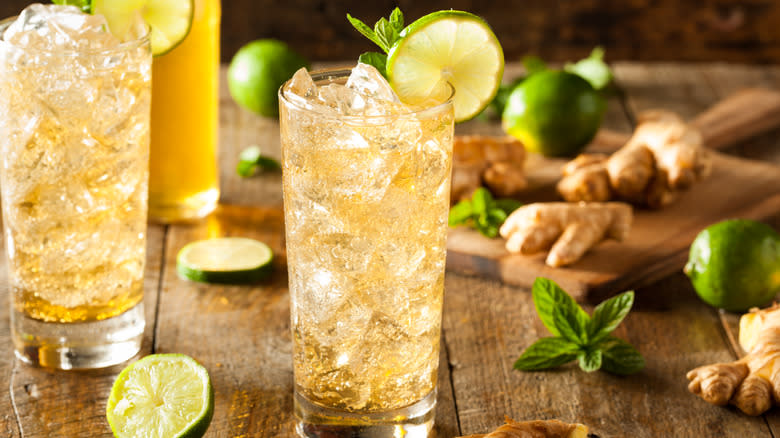
Ginger beer and ginger ale, as their names suggest, are flavored with the same ingredient, but these two fizzy ginger beverages can be quite different. One is spicier, and one is sweeter, but both are refreshing when enjoyed by themselves and both pair well with a variety of flavors for tasty mixed drinks or innovative cocktails. While it's possible to brew your own ginger beer or mix your own ginger ale at home, there are also lots of variations to choose from among the existing brands, both artisanal and mainstream, for each.
If you don't already have a favorite go-to ginger ale or ginger beer, we can give you some insight with a ranking of the best ginger ale and ginger beer brands — but the two beverages are different enough that, if you like the flavor of ginger, it might be worth keeping both on hand for all your home-mixing needs.
Read more: 10 Of The Healthiest Beers You Can Drink
What Is Ginger Beer?
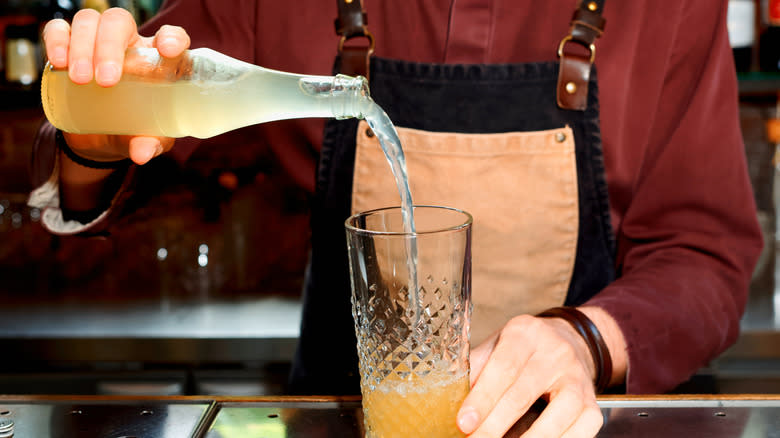
Ginger beer, despite its name, has nothing to do with beer except that, like beer, it's produced through a brewing process (albeit a much simpler one). Originating in England, this sweet elixir with a bit of kick, similarly to its pre-colonial cousin root beer, was part of a trend of beverages brewed from roots and barks around the 1700s. These were known as "small beers," due to their lower alcohol content. Then, as now, ginger beer recipes take a few key ingredients, including grated ginger and an acidic compound, which are fermented together to produce a spicy brew.
Once it's ready to consume, ginger beer gets bottled and refrigerated, so as to stop the fermentation process early. Similar to other fermented drinks like kombucha, ginger beer takes on a natural carbonation, known as effervescence. The result is a zesty, fizzy beverage with a strong ginger flavor, equal parts spicy and sweet.
What Is Ginger Ale?
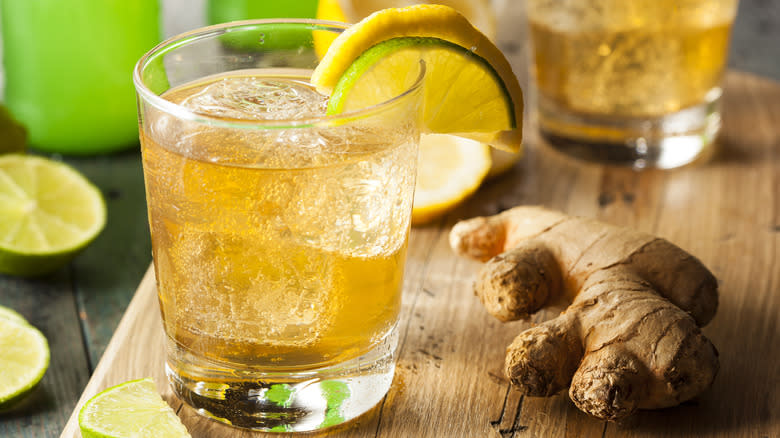
Ginger ale, despite the name, also has nothing to do with ale. The basic formula is less complex than ginger beer, consisting of sparkling water mixed with a sweet ginger syrup. It may have originated in 1850s Ireland, as many anecdotes attribute the invention to Thomas Joseph Cantrell, an Irish doctor who may have taken inspiration from English ginger beer. But the Swiss beverage company Schweppes, founded by Geneva jeweler Jacob Schweppe in the late 1700s, also seems to have been proffering ginger ales among other health tonics around the same time, if not before. Whether ginger ale got its start in Europe or the UK, it quickly sprung up in North America in the 1860s when James Vernor, a pharmacist in Detroit, Michigan, introduced Vernor's Ginger Ale to the American populace.
But it wasn't until the early 1900s that ginger ale really hit its stride, and it became most popular in Canada. This beverage proved to be an ideal pivoting point for John J. McLaughlin, owner of a Canadian sparkling water manufacturing plant, who seized the turn of the century trend of ginger sodas by mixing ginger flavoring with his own carbonated product. He found instant success marketing his elixir as a superior, subtle soft drink, the "champagne of soda." His creation went on to become Canada Dry Ginger Ale, which remains one of the world's most popular and recognizable ginger ale brands today.
Ginger Beer Can Contain Alcohol
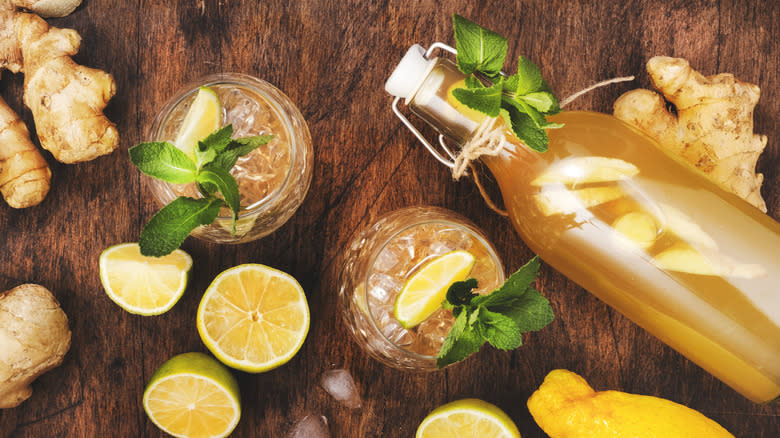
Thanks to the fermentation that goes into producing ginger beer, it naturally contains a small amount of alcohol. In previous centuries, ginger beer was often brewed with the intention of being alcoholic, and could contain between 10-11% alcohol by volume if left to ferment long enough, which is more than the average modern beer or cider (which typically range from 4-7% ABV) but less than many wines (which often fall between 11-14% ABV).
Today, unless it's intentionally brewed to be alcoholic — some ginger beer brands contain between 1% to 5% ABV, which requires them to remain in the liquor aisle — most commercial ginger beers are bottled quickly, before fermentation finishes, and some brews contain added carbon dioxide. All of this helps keep the alcohol content to a minimum. Most "non-alcoholic" ginger beers contain no more than 0.5% ABV — a small enough quantity, and the maximum permissible, to allow these ginger beers to legally be considered non-alcoholic.
Ginger Ale Is A Ginger-Flavored Soft Drink
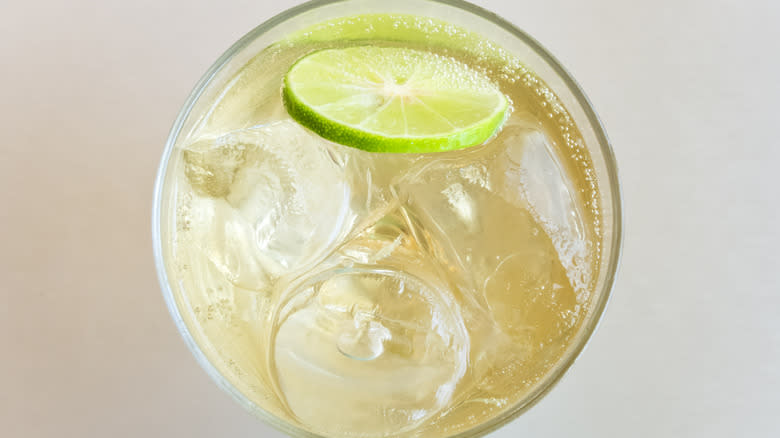
Though it may be characterized by ginger flavor, ginger ale often contains no true ginger root among its ingredients. Some brands use natural ginger extract, but many simply add artificial ginger flavoring. Today's ginger ales are generally composed of the same simple combo that defined the original Victorian recipes, combining ginger-flavored syrup or ginger extract mixed with sparkling or tonic water with a little caramel coloring. Some ginger ales are actually fermented with whey, the liquid strained from yogurt or during cheesemaking, and thus bridge closer to the realm of ginger beers. But most ginger ales entail no brewing process, and are identifiable as gold tinged, subtly ginger-flavored sodas.
Due to their mild sweetness, ginger ales — especially the Canada Dry brand — gained popularity in the U.S. during the 1920s, when they were widely used as a mixer or a chaser for the bootleg alcohol proffered at speakeasies and clandestine parties during the Prohibition era. The sweet gingery melange masked the unpalatable flavor of harsh, home-brewed liquors, and solidified ginger ale's place as a bar-side essential. Today, ginger ale remains an integral ingredient in mixed drinks both virgin and alcoholic, from the Shirley Temple to the ginger shandy, and beyond.
Ginger Beer Is Spicier
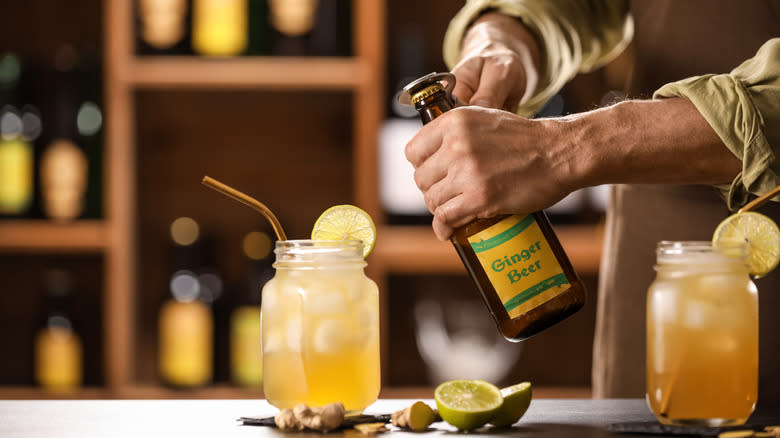
Because it's made with pure, fresh ginger root, ginger beer retains the root's flavor, and thus has a bit of a natural kick. The flavor, of course, depends on how much ginger is added and how long the mixture has been left to ferment. Some ginger beer brands do include added ginger flavoring, but overall, ginger beer compared to ginger ale tends to be flavored with a more concentrated kick of ginger, and some variations can be quite spicy indeed.
Even in brands which add carbon dioxide to achieve synthesized effervescence, ginger beer never really qualifies as a soda. The color can be off white to murky gold, and bottles will often contain a bit of sediment at the bottom, evidence that this potion is brewed from natural ingredients. For those who enjoy ginger's taste, ginger beer will offer a more intense flavor. But for those who don't prefer spicy, it can be a bit intense.
Ginger Ale Comes In Different Flavors

There are two main varieties of ginger ale — dry and golden. Dry ginger ale tends to be have a stronger ginger flavor, whereas golden ginger ale is generally much sweeter. Both varieties tend to have less zing than ginger beer, and due to this lack of natural kick that raw ginger provides for ginger beer, some ginger ale brands add capsicum to their beverages, which provide a similar effect to ginger's natural spice while avoiding the cost of using pure ginger.
In any case, because it's relatively mild, ginger ale mixes well with a variety of flavors. No matter what kind of ginger flavoring is added to ginger ale, many kinds taste a lot more like lemon or lime soda than the ginger they're named for. This may be because some ginger ales include a combination of fruit juices into the mix. Some of the biggest ginger ale brands, like Schweppes and Canada Dry, even offer ginger ales that are flavored to be something else entirely — offering various berry and citrus-flavored ginger ales in addition to the original.
Ginger Beer Is The Star Of The Moscow Mule
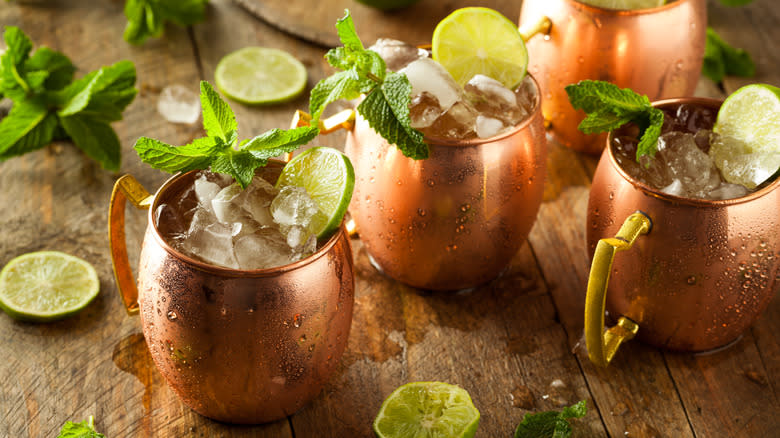
Ginger beer has been having a moment with the increasing popularity of the Moscow mule, a combination of vodka, ginger beer, and lime juice that has no real ties to Russia, and a mule association that no one can pin down. Really, the cocktail got its start in the 1940s in a Hollywood haunt with different animal associations, the Cock n' Bull. There, the beginning of a bad joke begins as three struggling businessmen found themselves in the same place.
The bar's owner, Jack Morgan, had not yet found many takers for his homemade ginger beer, until John G. Martin, the owner of the then struggling Smirnoff vodka operation, walked in, intending to drink his troubles away. He got to talking with Morgan and another struggling businessman on site who couldn't seem to sell his copper mugs. Deciding to pool their resources together, the trio developed the Moscow Mule trinity with a hint of lime. While ginger beer has gone on to become a primary ingredient in a few other noteworthy cocktails, such as the whiskey highball and the dark 'n stormy, the Moscow mule is largely responsible for jump-starting both vodka and ginger beer's popularity in the United States, as well as the popularity of copper mugs.
They Are Both Used To Remedy Stomach Aches
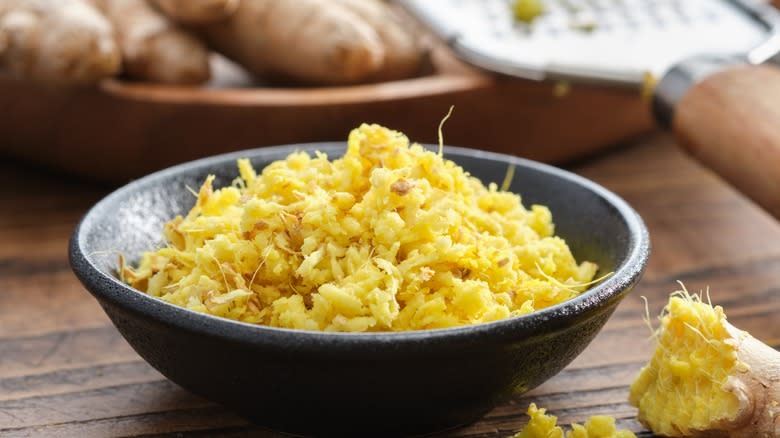
Ginger root has long been known to help with nausea and is an ancient remedy for digestive problems, which is probably why beverages with ginger in the title have been considered home remedies from the start. Ginger ale may be the more commonly used pantry staple to settle an upset stomach, and this may come from its historic associations with healthfulness. With its hazy origins hovering between an Irish doctor, a Swiss health brand, and an American pharmacist, ginger ale was originally intended to be used as a health tonic. However, since these elixirs rarely contain real ginger, today's ginger ale brands offer only minimal or placebo health benefits, though all the better if the effects are positive!
Ginger beer, while it may not have the historic association with wellness, and is less commonly used to combat tummy troubles, may in fact be the more likely elixir to offer some positive benefits. Due to the real ginger root used in the brewing process, it has the potential to be a true force against nausea. Furthermore, depending on the length of the fermentation process that provides ginger beer's effervescence, ginger beer may also contain natural probiotics, which are a helpful digestive agent as well. Since ginger beer contains a lot of sugar, it isn't necessarily a health food, but it can certainly be a tasty supplement for ginger tea as a way to soothe nausea or an upset stomach when enjoyed in moderation.
They Can Both Be Brewed At Home

Both ginger beer and ginger ale are easier to make from scratch than you might think. Ginger ale is especially simple, as it's just a matter of mixing ginger syrup with carbonated water. From there, it's only a matter of experimenting with the proportions to achieve the sweetness ratio you prefer.
Making ginger beer, though the process is a bit more involved than that of ginger ale, can also be fairly simple in terms of home brewing. The easiest variations use grated ginger, water, dry yeast, sugar, and an acidic compound — usually lemon juice, cream of tartar, or both. After only a few days, the mixture should be drinkable and kept in the fridge.
There are other more complex methods for making home-fermented ginger beer, which involve growing your own starter culture, also known as a "ginger bug." Since ginger naturally contains yeasts, the ginger bug entails leaving grated ginger to ferment naturally with sugar and water. This home fermentation process requires careful monitoring over a few days, but results in perhaps a more authentic old-style ginger beer brew. As with ginger ale, one big appeal to homemade ginger beer is that you can experiment with sweet and spice ratios to find the combination that works best to suit your tastes.
Read the original article on The Daily Meal


